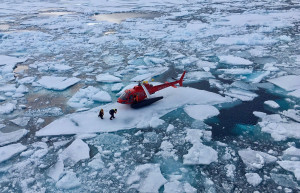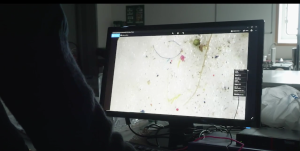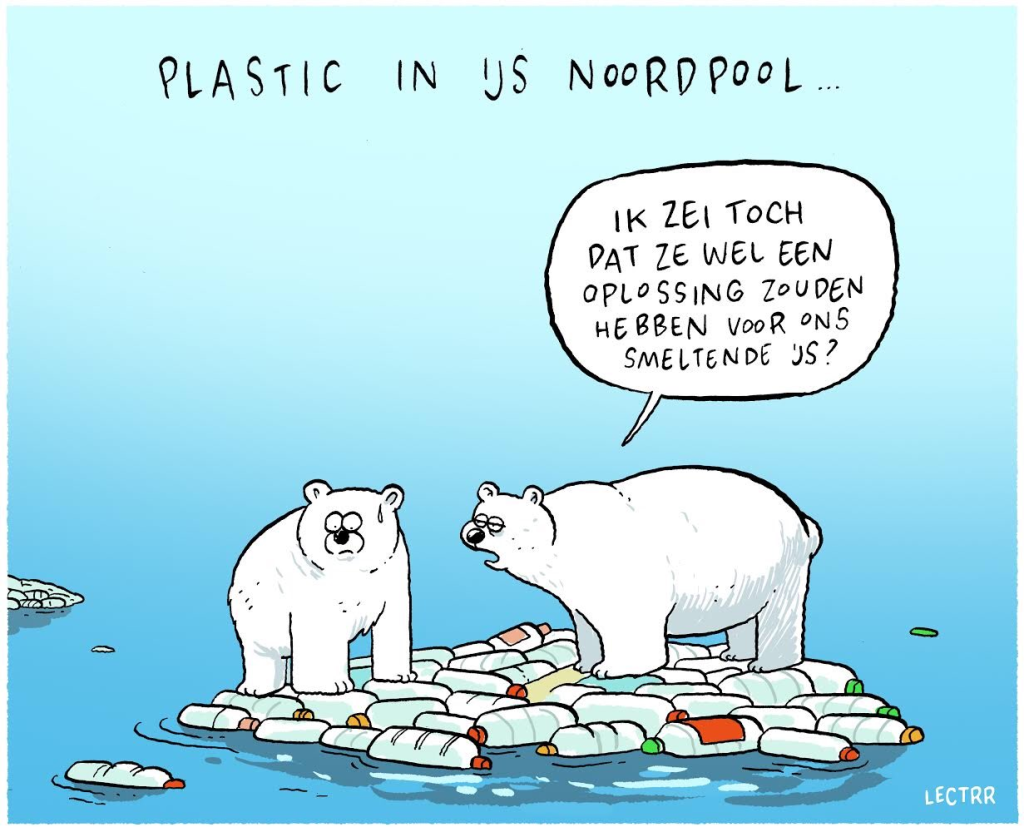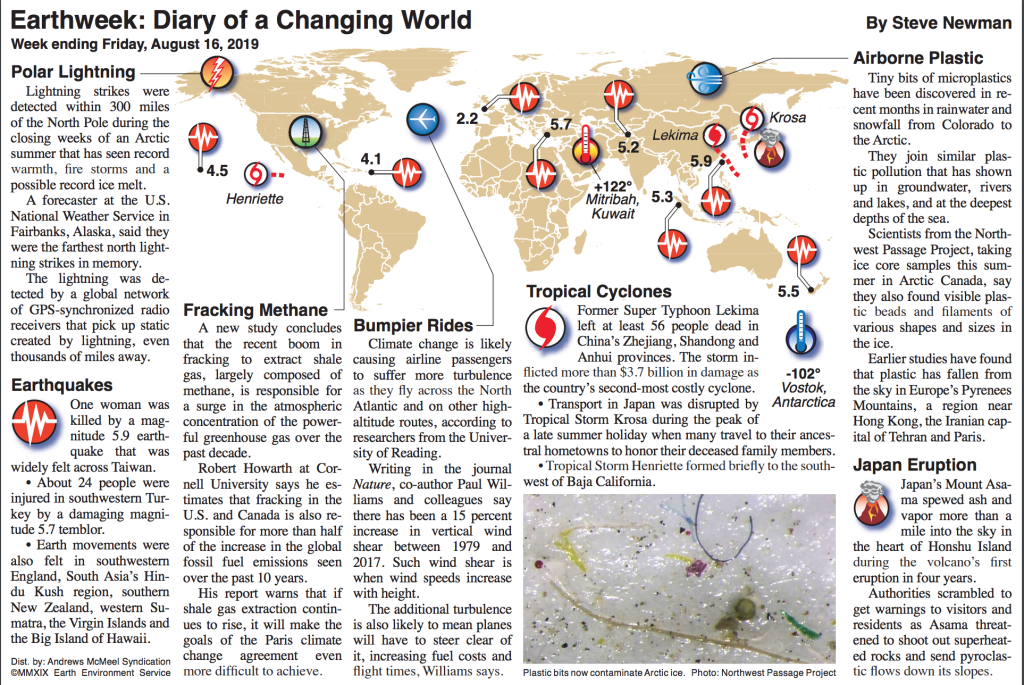Northwest Passage Project, University of Rhode Island, Inner Space Centre

Plastics visible in 2-metre sea ice cores in the Northwest Passage
Tiny pieces of plastic have been found in ice cores drilled in the Arctic by a U.S.-led team of scientists, underscoring the threat the growing form of pollution now poses to marine life in even the remotest waters on the planet.
Researchers led by Alessandra D’Angelo and Jacob Strock, University of Rhode Island, processed five of 18 sea ice core samples drawn from four locations in Lancaster Sound (73 to 74 degrees N, between 89 and 98 degrees W) in the vicinity of the hamlet of Resolute, one of Canada’s northernmost communities (pop. 200).
D’Angelo and Strock were were part of a scientific team on board the Swedish Icebreaker Oden during the
Northwest Passage Project (July 18 to Aug. 4, funded by the US National Science Foundation and the Heising-Simons Foundation).
While plastic has been documented in Arctic waters previously, “to our knowledge this is the first core sampling for plastic in the Northwest Passage,” says URI colleague Brice Loose, Chief Scientist of the NPP.
“Even knowing what we knew about … the ubiquity of plastic, for us it was kind of a punch to the stomach to see what looked like a normal ice core in such a pristine environment just chock full of this material completely foreign to the environment.”
“We haven’t dated the ice, however, it’s relatively straightforward to identify as multiyear by its thickness and salinity,” says Dr. Loose “Most of the multiyear cores were > 2 meters in length, which is quite thick for this time of year. The low salinity is another strong indicator that the ice is more than one year old.”
The ice “most likely originated in the Central Arctic,” he says. “In 2018 a large portion of old ice from the Lincoln Sea broke up and flowed south through Nares Strait (about 80 degrees N, between Greenland and Canada’s northernmost island, Ellesmere Island).”

“The 2018 ice charts show that Lancaster Sound near Resolute was mostly open in July, but became plugged with multiyear ice by late August,” he says. “I think this particular blockage entered Lancaster Sound from the East and eventually became incorporated into the 2019 ice pack.”
D’Angelo and Strock have brought melted and filtered ice core samples back to URI to separate the plastic bits from plankton and other organic material, measure the quantity of plastic per volume of ice, and to identify the plastics’ chemical composition using infrared spectroscopy.
Strock, a plankton expert, easily distinguished plastic from plankton, the latter identified by unique symmetrical shapes and by the chains and colonies they form; the larger ones even reveal their organs and internal structure. The plastic, by contrast, is asymmetrical, vivid in colour, and not translucent.
The samples reinforce the observation that ice concentrates plastic; it is far more abundant in the ice than in equivalent volumes of seawater.
Coverage:
Newswires
Agence France Presse
Arctic sea ice loaded with microplastics, click here; French, Un morceau de banquise gavé de microplastiques, click here, Spanish, Hielo marino del Ártico cargado de microplásticos, click here
Reuters, story 1, via the
Daily Mail, UK,
An Arctic ‘miracle’: Icebreaker salvages lost recordings of Beluga whales, click here; Spanish,
“Milagro” en el Ártico: barco rompehielos rescata grabaciones perdidas de cantos de belugas, click here, Serbian: Švedski ledolomac spasao naučnu bovu u vodama Arktika, click here; Hungarian: Egy svéd jégtörő hajó mentette meg a belugák énekét rögzítő, az Északi-sarkvidéken elsodródott felvételeket, click
here
Reuters, story 2: Punch in the Gut’ as Scientists Find Micro Plastic in Arctic Ice, via Daily Mail, UK, click here; French: Les scientifiques découvrent un microplastique dans la glace arctique, click here; Portuguese: Em soco no estômago, cientistas encontram micro-plásticos no gelo do Ártico, click here; Vietnamese, Phát hiện sốc trong lõi băng ở Bắc Cực – vùng nước xa xôi nhất, click here; Arabic, click here, Spanish, La enorme cantidad de plástico en el hielo del Ártico es un golpe en el estómago para los científicos, click here
Reuters TV, story 1 (beluga recordings salvaged), click
here; Story 2 (microplastics), click
here“52 broadcasters used the microplastic video”
Agencia EFE, Spain, Spanish: Los microplásticos se están acumulando en el hielo del Ártico, click here; Portuguese (via LUSA newswire, Portugal): Encontradas particulars de microplásticos pela primeira vez no Ártico, click here
TT News Agency (TT Nyhetsbyrån), Sweden (and Aftonbladet), Ljud från vitvalar räddade av isbrytaren Oden (Sound from whales rescued by the icebreaker Oden), click here
TV / Radio
Euronews, France, Des microplastiques découverts dans la banquise de l’Arctique, click here, English, Shock’ as scientists find plastic microbeads in remote Arctic ice, click here
TFI Television, France, click here
France 2 via Francetv Info, France,
Écologie : les flocons de neige contiennent… du plastique, click here
Stern, Germany,
Forscher finden Mikroplastik im Schnee, click here
CTV National News, Canada, click
here
CBC National TV, Canada,
Microplastics found in Northwest Passage ice, click here
TVN24 Television, Poland,
Śnieg z Arktyki pełen plastiku. “Jego wszechobecność to dla nas cios w serce” (“Arctic snow full of plastic. “It’s ubiquity is a blow to the heart for us”), click here
TRT World, Turkey,
Arctic Micro Plastics: Scientists find bits of plastic in remote area, click here
NPR Science Friday, USA, click
here
WBUR (NPR Boston), USA,
ON POINT: Melting Ice, Raging Fires: Summer In The Arctic, Courtesy Of Climate Change, click here
ABC National Radio, Australia, Scientists share real-time observations from the Arctic Ocean, click here
Le Figaro, France,
Pollution: il neige des particules de plastique dans les Alpes et l’Arctique, click here
RTL, France,
Arctique : la banquise polluée par des microplastiques, click here
The Atlantic, United States, Photos of the Week, click here
BuzzFeed, USA, Microplastics have been found in Arctic ice samples, click here
Mynet, Turkey, Plastik Atıklar Kuzey Kutbu’nun En Uzak Noktalarına Kadar Yayıldı, click here
Jezebel, United States,
Researchers Find That Arctic Ice Is Filled With Microplastic, click here
In print
Le Parisienne, France
Earthweek, USA
De Standaard, Netherlands
“I told you they would have a solution for our melting ice”

Full coverage summary, click
here
News release in full, click here

 “The 2018 ice charts show that Lancaster Sound near Resolute was mostly open in July, but became plugged with multiyear ice by late August,” he says. “I think this particular blockage entered Lancaster Sound from the East and eventually became incorporated into the 2019 ice pack.”
“The 2018 ice charts show that Lancaster Sound near Resolute was mostly open in July, but became plugged with multiyear ice by late August,” he says. “I think this particular blockage entered Lancaster Sound from the East and eventually became incorporated into the 2019 ice pack.”

